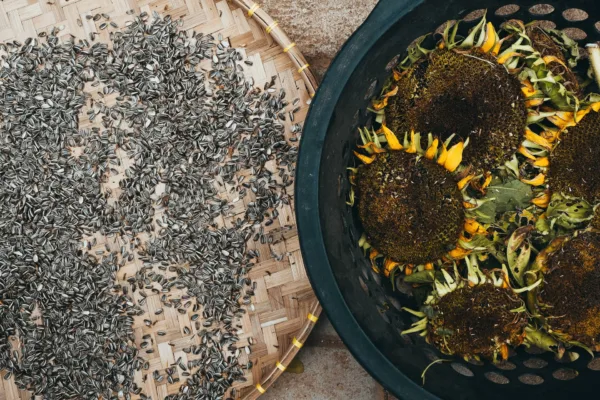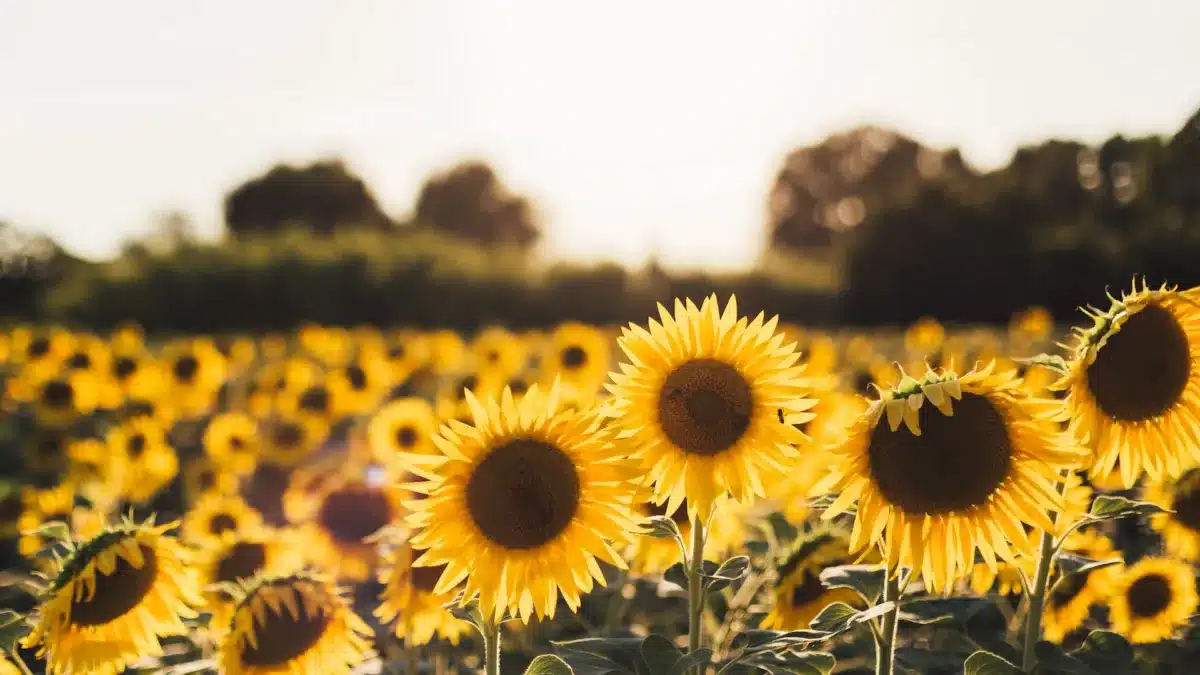The mighty sunflower – a summertime staple that will surely brighten up any greenery space. It is impossible to look at their spectacular vivid blooms and awe-inspiring size without feeling a sense of joy and delight. No wonder they capture the hearts and imaginations of gardeners everywhere so easily.
They are like the little drops of sun rays in your backyard! Just imagine walking up to your garden to be amazed by a field of sunflowers reaching the sky, swaying their vibrant petals in the gentle breeze. Are you searching for something cheerful to brighten up your upcoming summer garden? Then sunflowers might just be what you need.
What’s Not to Love About Sunflowers?
The thing that people adore so much about sunflowers is the way they radiate joy and positive vibes everywhere they go. And, come to think of it, they’re much like the cheerleading squad of your garden! They’re the star of the show in any garden or floral arrangement, adding a burst of energy and life to any space.
And bee-lieve it or not, sunflowers are the life of the garden party as they attract pollinators and beneficial insects anywhere they go. That’s why sunflowers make excellent plant companions. Bees and butterflies rely on the rich nectar of sunflowers as a food source. These tiny garden helpers buzzing around not only ward off harmful pests and diseases but also enhance pollination rates for nearby plants.
Man, I’m not even finished with the reasons to fall in love with this flower. These eye-catchers are nature’s way of lending a hand. Because of their extensive root systems, they are able to loosen and aerate compacted soil, improving drainage and aeration. Did you know that sunflowers are natural detoxifiers? They are able to absorb toxins, pollutants, and even heavy metals from the soil. How cool is that?
Even cooler, when the sunflowers have passed their prime blooming time and withered away, their seeds can still be used in all sorts of recipes, from tasty salads to homemade granola. So, don’t let those sunflowers go to waste, but don’t keep them all to yourself, either. Sharing is caring, the birds love these tasty treats too! Planting sunflowers can transform your garden into a vibrant and lively oasis. Your garden will be the buzzing talk of the town. Now, without further ado, it’s time to sow some sunshine in your garden.

When is the right time to start?
Once the final frost date has passed in your location and the weather gets warmer, it’s the perfect moment to begin your sunflower journey. Hence, sunflower seeds are best sown in the spring, when the soil temperature reaches at least 13°C. Sunflowers can be planted in the summer or fall in regions with warmer climates as long as they have enough time to mature before the first frost. Planting sunflowers too early can be risky, as the cold weather would be too harsh for seedlings to survive. But if you wait too far into the season to get started, these stunning flowers may haven’t fully flourished before the cold sets in again. Thus, timing is very important!
Ultimately, the best time to grow sunflowers will depend on your specific growing conditions and climate. Before planting anything, do some research and familiarize yourself with the average frost dates and the hardiness of your zone to have a better grasp of your local environmental conditions. Better yet, take a trip to your local garden center or nursery to get the sunflower seeds of varieties that have already been well-acclimated to your region. And while you’re there, don’t be afraid to ask for help from experienced staff. Who knows, they might give you some priceless pieces of advice on how to plan and care for your future sunflower garden. So don’t let this golden opportunity slip away!
Choosing the Right Sunflower Seed for Your Garden.
There’s something satisfying about watching little seeds emerge into tall plants with giant flowerheads. And to do so, you must first seek the right seeds for your sun-kissed garden.
- Size: Sunflowers come in so many sizes. There are huge ones, such as the “Russian Giant” variety that can tower up to 14 feet, to the tiny “Teddy Bear” that only grows to about 2-3 feet tall. So it’s best to keep your garden space in mind to find a balance between aesthetics and growing conditions. Make sure your sunflower troop fits in their living space and gets along with the rest of the plant gang.
- Climate: Each sunflower variety has its own likes and dislikes regarding sunlight, temperature, and humidity. Some varieties can tolerate high temperatures, while others seek cooler weather. Some definitely love to spend hours basking in the sun, while others favor a bit of shade. It’s also worth noting that some sunflower varieties thrive in shorter growing seasons while others prefer to take their time. Generally, they’re not particularly picky about their environment, but then again, they are the prettiest when being raised in a home that meets their requirements.
- Purpose: Are you looking for a garden full of beautiful blooms, a bounty harvest of tasty seeds, or a buzzing party of pollinators? If aesthetics is your top priority, grab a variety with enormous, attention-grabbing blooms. And to lure in more beneficial insects, choose those that are rich in pollens. But if you’re heading for that seed life, pick the kinds that are filled with plump, juicy seeds.
- Personal preference: With a wide range of colors (yellow, orange, bronze, dark red, white, and even bi-colored), petal shapes (long, short, fluffy, elongated), and head types (single heads or multi-flower heads) to choose from, there’s a sunflower variety out there for everyone. Whether you prefer classic yellow or bold red, you can mix and match to create your own unique garden paradise.
- Soil type: Some sunflower varieties are better suited to different soil types. For example, some varieties do well in clay soil, while others prefer well-draining soil. By choosing a variety that is well-suited to your soil type, you can help ensure that your sunflowers thrive.
- Seed quality: Go for those plump and healthy-looking ones. Just don’t waste your time on old, discolored, or visibly damaged seeds, as they may not germinate properly, which can result in stunt growth or even failure to sprout.
Ready, Set, Grow!
But growing sunflowers requires more than picking out the right seeds. It’s also about understanding how to care for them. Even though sunflowers are known to be super easy and low maintenance, they still need some tender loving care to grow! Ready to create the ideal environment for your sunflowers to thrive? Let’s go from seeds to splendors!
- Sunny Side Up: These flowers really love full sun. Place them in a spot that receives at least 6 hours of direct sunlight daily for them to really strut their stuff.
- Quality Soil, Quality Blooms: Sunflowers can handle a broad range of soil types, but they flourish best in well-draining, aerated and organic-rich soil.
- Let’s Get Sowing: Sunflower seeds can be directly sown to the soil during springtime. Locate a nice patch of fertile soil, dig shallow holes (about 2 inches deep), and carefully place 2-3 sunflower seeds in each.
- They Need Their Space: Give your sunflowers plenty of breathing room because their brilliant blossoms will spread far and wide as they mature. For larger varieties, like the magnificent Mammoth Sunflower, you might want to avoid growing any other plants within 24 inches. But for smaller varieties, 6 inches of growing space should do just fine.
- Water You Waiting For?: Sunflowers are thirsty plants, especially during their early growth phases. The seeds need to be watered regularly until they fully sprout. After sprouting, you can reduce watering to once a week. But beware of overwatering! The operative keyword here is “moist,” not “waterlogged.”
- Thin It to Win It: Once the seedlings reach a height of 2-3 inches, thin them out to one plant per hole. Choose the strongest and healthiest seedling to keep and remove the others.
- Feed The Need: Applying fertilizer on a regular basis also benefits the development of robust and healthy sunflower troops. The ideal fertilizer would contain a balanced distribution of nitrogen, phosphorous, and potassium. Fertilize once a month following the instructions on the seed packaging, and watch your sunflowers reach new heights of beauty.
- Hot-Headed Sunflowers: Sunflowers are heat-tolerant plants that can handle the heat. But most of the time, they still require some particular “chilling time” to germinate and flourish. They are annuals that thrive in the temperature range between 21 and 26°C. If you live in an area with hot and arid summers, keep your sunflowers fully hydrated to prevent them from drying out.
- Don’t Get Blown Away: Planting sunflowers near a sturdy fence or windbreak to provide natural protection from strong winds. You can also use stakes or supports to ensure your sunflowers remain tall and proud, even after severe weather.
- Fighting Off the Flower Foes: As much as the good bugs love sunflowers, the bad ones can’t resist their charm either. These blooming beauties can easily become a target for sneaky pests like aphids, whiteflies, and cutworms, which can cause nasty plant diseases. So always be on the lookout for those pesky buggers and ready to take action!
- Reap What You Sow: When the flowers start to droop and turn brown, it’s time for seed harvest! Get a sharp knife, remove the heads, leaving a 12-inch stem, and hang them upside down in a dry, well-ventilated place. Once the seeds are dry completely, pluck them out and store them in an airtight container. And there you have it, some sunflower seeds to munch on or to save for the next growing season.
Then, why settle for a dull summer garden when you can have a colorful one filled with sunflowers? If you want to attract all the right kind of attention to your outdoor space, plant some sunflowers and have a blooming good time watching as they steal the show with their charm and charisma. Trust us, you won’t regret it.

